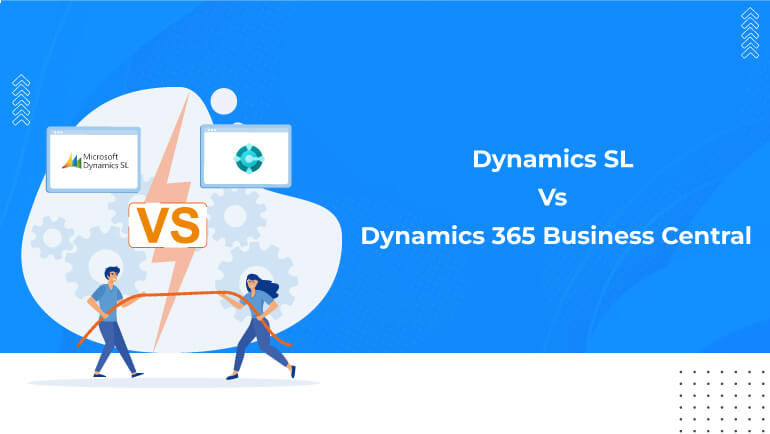Difference Between Microsoft Dynamics SL and Dynamics 365 Business Central
Finalizing an enterprise resource planning (ERP) software can be challenging, especially with the multiple ERP systems available. In this article, we will look into two prominent Microsoft Business Solutions:
- Microsoft Dynamics SL
- Microsoft Dynamics 365 Business Central
While Microsoft Dynamics SL caters primarily to project-driven organizations, offering complete financial and project management functionalities. However, with its impending end of life announcement, businesses are seeking alternatives.
And Dynamics 365 Business Central is a cloud based ERP solutions for enterprises of all sizes. Offering a suite of features including:
- Financial Management
- Sales and Service Management
- Supply Chain Management
- Project Management
- Operations Management
Business Central provides a modern, scalable, and cost-effective solution. Dive deeper into the nuances and benefits of transitioning from Dynamics SL to Business Central. Uncover the crucial distinctions that can elevate your business and position it for enduring success.
What Is Microsoft Dynamics SL Software?
Microsoft Dynamics SL is an enterprise resource planning (ERP) software designed for project-driven small to midsize businesses (SMBs). It was originally developed by Solomon Software and in the year 2000 it was acquired by Microsoft; it has almost 40+ years of existence. For the past two decades, Microsoft Solomon has been able to remain competitive because of its frequent updates, advanced features, and customization options. It helps to manage financials, projects, and resources efficiently. Microsoft SL end of life date for extended support of second life remains July 11, 2028, whereas mainstream support ends in January 2024.
What Is Dynamics 365 Business Central?
Microsoft Dynamics 365 Business Central which is formerly known as Dynamics NAV is a cloud-based ERP solution that streamlines business processes for small to medium sized businesses. The Business Central application is a cloud-based Software as a Service (SaaS) that enables users to access from anywhere at any time.
Businesses of all sizes can use Business Central to manage their finance, purchase, inventory, supply chain, customer relationship, and streamline operations. Microsoft Business Central integrates with other Microsoft products such as Office 365, Microsoft Power BI, and Microsoft Teams.
As a modern ERP system, Business Central Microsoft offers scalability and accessibility, empowering businesses to adapt and grow in these coming times. A detailed view of business operations is delivered by Dynamics 365 Business Central, with real-time insight on every aspect of the business operations. Microsoft BC gives users an interactive and responsive interface for making smart decisions and collaborating with others.
Why Upgrade from Dynamics SL to Business Central?
Migrate from Dynamics SL to Business Central reveals several prevalent challenges associated with remaining on Dynamics SL. These include limited reporting functionalities, siloes data leading to inefficiencies, manual processes, and a lack of real-time insights. Moreover, businesses encounter:
- Complexities in data evaluations,
- Heavy reliance on IT for reporting tasks,
- Restricted visualization elements,
- Inability to add multiple data sources.
Addressing these issues is essential for organizations seeking to optimize their operations and full potential of their ERP. By migrating to Dynamics 365 Business Central businesses can overcome these challenges and see a streamlined, efficient, and data-driven approach to managing their operations and decision-making processes.
Microsoft Dynamics SL vs Dynamics 365 Business Central
Microsoft Dynamics SL and Microsoft Dynamics 365 Business Central differ in functionality, deployment, scalability, cost, and more. Explore the key factors that differentiate these two.
1. Target Audience
- Microsoft Dynamics SL – Microsoft SL caters primarily to project-driven organizations like professional services firms and government contractors, offering management and financial functionalities to their needs.
- Microsoft Dynamics 365 Business Central – Business Central is designed for small to medium-sized businesses across industries, providing a comprehensive suite of functionalities for efficient management. You can also get Business Central Training for your employees and key stake holders.
2. Functionality
- Microsoft Dynamics SL – Offers extensive project management and financial management features.
- Microsoft Dynamics 365 Business Central – Provides a broad range of functionalities including financial management, sales, service, supply chain, project and operations management.
3. Deployment
- Microsoft Dynamics SL – Typically deployed on-premises, requiring organizations to maintain their infrastructure.
- Microsoft Dynamics 365 Business Central – Cloud-based solution hosted on Microsoft Azure, offering greater flexibility and accessibility.
4. Scalability
- Microsoft Dynamics SL – May have limitations in scalability, requiring additional investments in infrastructure for growth.
- Microsoft Dynamics 365 Business Central – Highly scalable, accommodating changing business requirements seamlessly without significant disruptions.
5. Cost
- Microsoft Dynamics SL – Involves upfront licensing fees, hardware expenses, and additional costs for customizations, integration of third party apps and maintenance of infrastructure.
- Microsoft Dynamics 365 Business Central – Follows a subscription based pricing model with monthly costs and no upfront expenses for Business Central Licensing and Business Central Pricing.
6. Integration
- Microsoft Dynamics SL – May require additional integrations for connecting with other business systems.
- Microsoft Dynamics 365 Business Central – Offers seamless integration with Microsoft products and third-party solutions, streamlining workflows.
7. Customization
- Microsoft Dynamics SL – Allows for customizations but may require additional resources for development and maintenance.
- Microsoft Dynamics 365 Business Central – Provides built-in tools for streamlined development and rapid deployment of customizations.
8. User Interface
- Microsoft Dynamics SL – User interface may vary and may require training for effective use.
- Microsoft Dynamics 365 Business Central – Offers a modern, intuitive user interface compatible across devices and platforms.
9. Support and Updates
- Microsoft Dynamics SL – Microsoft announced the sunsetting of Microsoft Dynamics SL after 2024, posing challenges for ongoing support and compatibility.
- Microsoft Dynamics 365 Business Central – Benefits from continuous updates and enhancements through Microsoft’s cloud platform, ensuring access to the latest features and compliance requirements without manual upgrades.
Conclusion
Microsoft announced the sunsetting of Microsoft Dynamics SL Software (or Microsoft SL end of life), meaning it will no longer receive updates or support after 2024.
There is an increasing trend among businesses to use cloud-based business management systems like Microsoft Dynamics Business Central. It may be difficult for users to accept at first, but businesses need to switch to these systems in order to remain competitive.
Shifting from Dynamics SL to Business Central offers businesses a streamlined, efficient, and data-driven approach to managing their operations. With its:
- Cloud-based Infrastructure
- Amazing Functionalities
- Effective Pricing Model
Choose a Business Central partner and experienced Dynamics 365 Business Central Consultant for Business Central Implementation and empower your business to adapt and thrive more than what they forecasted.


